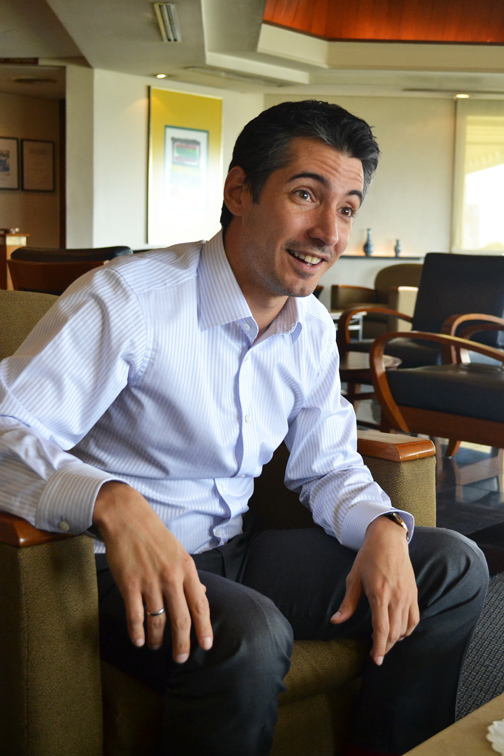 AT 10:50 A.M. on June 19, Christian Gonzalez whips out his iPhone in the middle of an interview with PortCalls.
AT 10:50 A.M. on June 19, Christian Gonzalez whips out his iPhone in the middle of an interview with PortCalls.
“See, right there, overall 63.69%, Berth 6, 60.9%,” the Asia Region head and vice president of International Container Terminal Services, Inc. (ICTSI) says, pointing to some figures on his phone. They are an hourly update on yard utilization at the 2.5-million twenty equivalent units annual capacity Manila International Container Terminal (MICT), where he is also general manager. “This is a very efficient level to be at…this is far from capacity.”
Breezing in from another meeting, Gonzalez sat down with PortCalls that dreary morning and talked about updates on ICTSI’s local operations and a few other things.
“I think this terminal is prepared for anything that is thrown at us,” he says at one point.
For the better part of the interview, it’s clear the issue of port efficiency is top of mind for Gonzalez.
He goes through great lengths explaining how bad weather and holidays create peaks in utilization and affects efficiency at MICT, ICTSI’s flagship facility.
“In the middle of the year, the weather is a huge problem and the holidays are a huge problem. Our capacity is for seven days a week, but we only have the outflow five and a half days.”
He rues that August has three official holidays and those lost work days are normally compounded further by storms.
“August is always a problem because you have normally three holidays: Ninoy (Aquino Day), (Araw ng) Kagitingan, Eid (al Fitr). In the last few years, the death of (Iglesia ni Cristo head Eraño) Manalo, which they declared a holiday, and the death of (former President) Cory (Aquino), which they also declared a holiday. You put five holidays in one month, sabayan mo ng dalawang bagyo (throw in two typhoons) where for another five or six days walang maglalabas ng kargamento (no one brings out cargo). Dagdagan mo ng apat na Linggo (Add four Sundays), that’s nine. Dagdagan mo nang limang araw na may baha (Add five days of flooding), that’s 14. How much time in one month for people to pull out their cargo – half the month. All of a sudden the flow out of the terminal has been cut in half, right?”
In such a situation, “you’re going to bring your utilization level from 55, 60 to 90 (%).”
And just like a restaurant, he says, “If you’ve got five waiters working with 20 customers, it’s no problem. The minute you get 40 customers and your waiters are only two or three, it becomes slower, naturally, because you’re having to do more work.”
Gonzalez also pays close watch over another gauge of port efficiency: container storage. He says in the ideal setting, the yard shouldn’t be used as storage.
“No terminal that we operate anywhere in the world other than Africa has storage as a primary driver of revenue. Storage is supposed to incentivize people to take their containers out. It’s not meant to make money for the company,” he notes.
“In fact, we prefer to have zero storage on our books because, first of all, storage can go one day or another. Kung kumikita ka lang sa (If you’re earning just from) storage, ang nakakatakot doon baka the next day wala na, di bagsak ang kita mo (the difficult part is when stored containers are gone the next day, and your earnings drop). But if you have zero storage on your book, that means containers are flowing consistently …it’s a big sign of efficiency.”
That’s why he says it may be a good idea to adjust storage fees after a certain storage period. “We told the PPA (Philippine Ports Authority), ‘If you want all the ports nationwide to operate in a more efficient manner, this is how you send a message that you do not want people using government property as a bodega (warehouse).”
He says he is emphasizing the issue of storage “because if you’ve got a terminal that’s only 60% or 70% full and a truck comes in to take a container, there’s a good chance the crane moves the container right away.
“But when you start to go 80-90 % napapatungan na yung mga (there’s a pileup of) containers that were here 3-4 days ago, the ones that had been processed by the BOC (Bureau of Customs). So, per move per truck, instead of moving one container or two, you’re now moving three, four, five. It takes double the amount of time. Then multiply that by 3,000 trucks a shift – 6,000 trucks. It’s like you handled 12,000 instead of 6,000. Then compound that daily. So, people misinterpret a lack of facility space for a spike in demand caused by outside issues.”
Holiday hangover
At MICT, he points out work has not stopped since June 12, 1988, when the facility started operating. There is always a full work force, “not skeletal”, he notes, providing service any time a customer, ship or a truck comes in.
He says the terminal closes only three days a year – Christmas, when the family gets together; New Year; and Good Friday, when the family needs to be together for religious activities. And even then, he says, employees are offered a one-time bonus plus overtime.
The port boss points out Sundays and holidays create an “up-and-down pattern” in MICT’s operations.
“Sunday is seriously a lull day. In reality our capacity is for seven days,” but that there’s one-and-a-half days of lull in cargo inflow over the weekend.
“Your utilization starts like this,” Gonzales draws a roller-coaster line in the air. “Up from Monday then down to Saturday morning, goes to that then over the weekend biglang tataas uli (there’s an uptick) because walang naglalabas ng kargamento (no one brings out cargo). The minute bumagyo (a storm comes), that spikes up again. So hahabulin mo yung (you chase the) backlog before you can go with the flow again… What you want in this business is as much certainty as possible.”
Congestion
Asked about the issue of congestion, Gonzalez turns emphatic: “The term port congestion is extremely wrong! The only time you have port congestion is when ships with fixed schedules are actually waiting to get in.
“No ship here on window will have to wait for a berth. Period. Even in the tough times of the end of 2010, the people that had window still got in within their windows. You have to understand that people are given a schedule. It’s agreed upon between the customer and ourselves. This is your time to come in. If they don’t come in, you’re going to give the slot to somebody else who’s waiting.”
Berth 6 teething problems
Moving to Berth 6, Gonzalez said heavy rains, floods and issues with neighboring informal settlers were part of the teething problems encountered since the berth opened in June last year. “We had a very inopportune (confluence of problems). Sumabay-sabay yung baha, bagyo (We had flooding and storms), issues with power supply. And, actually, the relationship with the neighbors,” he says.
“But the real teething problem was related to power supply that was affected heavily by the storms last August. Dealing with the issue, a lot of the weak points in any network that you have, IT network, electrical network, operating network you only really find weak points in the chain when a problem happens. There’s no perfect opening with anything.”
He adds, “We double- and triple-check everything. But at the end, until you really use something to full capacity, you really won’t see where the faults are…And once we’ve seen where the faults are, we’ve brought in the top experts from the UK and everywhere and we’ve created all sorts of redundancies and corrective measures to make sure that’s a fully operational berth in good times and bad times… when you have no power coming from the grid, when you have your own internal power issues. And there is redundancy after redundancy.”
A third crane has just been brought into Berth 6 even though Gonzalez says most of the ships that sail in require only two cranes. “That shows our commitment to having service redundancy in every shape or form.”
Berth 7
Meanwhile, construction of the terminal’s Berth 7 is ahead of today’s market requirements.
“Berth 7 as per contract is supposed to be constructed for 2-million TEU. A lot of the necessary buildup work, reclamation, below-surface work. When we bought the piles for Berth 6, we also bought the piles for Berth 7. We laid those piles so they’re there already. The sand dredged out from the front of Berth 6 to create a berth pocket was then dumped into where Berth 7 is. So, effectively we have the sand surface and the piles on the quay side so we can build it very, very rapidly.”
Asked how fast the yard can be put up, he is quick to reply: “If the market requires it, we put ourselves in a position so we can put it out very, very quickly… we can put the yard up in six months. The quay – the difficult part is done, it’s a matter of building the deck, which takes a bit longer. ..We’ve moved ahead of the requirements of the market in terms of preparations. When the market demands that this kind of capacity is in place, we can have it very, very quickly, so no issues are created for the port.”
Hijo Port
Another ICTSI facility, the newly acquired Hijo International Port in Tagum City, Davao del Norte, will “be able to get interim operations running soon, in a matter of weeks,” says Gonzalez.
“The port has a detailed phased development plan that’s set up that way to meet the market demand, be prepared for any decision that the PPA takes on Sasa (wharf), and compete vis-a-vis the other people operating there. So, we can actually deploy capacity and equipment very, very quickly depending on what demand and what requirements people have.”
Based on plans, Hijo will have an annual capacity of 2 million TEUs, an area of 54 hectares and a 12-meter draft.
Faith in economy, love for industry
The Asia region head says he’s optimistic of the Philippine economy, which he describes as a “super sexy economy”.
“I think the government has done a lot making it an attractive place, both governments, this and the previous in terms of economic policies.
“I think everybody is doing their best and I think now is the time that people realize, ‘Wow we can really be good!’,” Gonzalez said.
Asked if he ever saw himself out of the port industry, his answer was quick: “No. I like this business a lot. I like the people here. Any business has a cutthroat mentality but no other business will get you a combination of engineering, information technology, people management, customer interaction that you do in this business. None.” – Text and photo by Roumina Pablo





